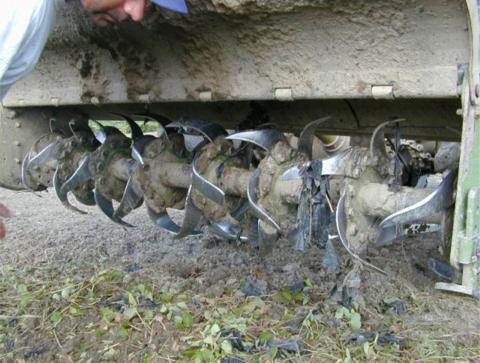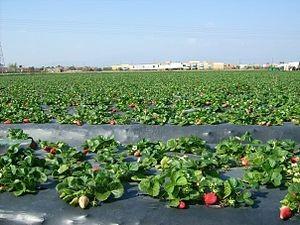Dr Stephen Chapman: IBERS, Aberystwyth University.
Take home messages:
- The agricultural industry is a major consumer of plastic
- Plastic mulch and silage wrap waste is expensive to dispose of correctly
- Biodegradable and compostable plastics offer a suitable alternative to fossil oil-based plastics
Benefits and concerns of using plastic in agriculture
The discovery of plastic and its range of beneficial applications has changed the way we live our lives. Plastic serves several important functions in today’s society such as protecting vulnerable products from damage whilst in transit, and from contamination or damage from moisture, microorganisms and light. The use of plastic films for soil mulching reduces weed growth, water use and the washout of nutrients from the soil. Therefore, soil mulching contributes to a more sustainable agricultural production system.
An estimated 2-3 million tons of plastics are used in agriculture each year and the use of plastic in agriculture is so prevalent it is now referred to as ‘plasticulture’. By far the biggest use of plastic in agriculture is for plastic mulch films and silage wrap. These are typically made from polyethylene (PE) because it is cheap, easily processed, highly durable and flexible. However; it is because of PE’s non-biodegradable nature, that it is now becoming an environmental concern. Rather than biodegrade, PE undergoes a process of light induced ‘oxo degradation’, which results in the breakdown of PE film, in the presence of light, to microplastics, that are unobservable to the human eye. The concern here is that microplastics are finding their way into the food chain and the effects of microplastic bioaccumulation on animal and human health are not yet fully understood.
Most mulch films are produced from petroleum-based plastics, usually Polyethylene (PE) which result in a considerable waste disposal problem. Because of the non-biodegradable nature of PE, disposal options are limited to being burnt, sent to landfill, recycled or simply left in the field, with each option presenting different environmental burdens. Burning of plastics releases aromatic hydrocarbons and results in
indiscriminate exposure and it is for these reasons that the Incineration Directive (Directive 2000/76/EC) was drafted, which prohibits uncontrolled burning of waste. The useful life of mulch film exceeds the duration of crop cycles so is usually left in the soil. Collection of the residual plastic is time consuming and involves the use of machines and hand labour, and collected plastic requires ongoing collection and disposal costs.
If left buried, PE films will never completely disappear from the field, leaving remnants which remain in the soil, which clog and choke machines when ploughing and harrowing fields. PE is recyclable, hence PE mulch films should be recycled. However, when contaminated with soil, sand, silage or other materials, this becomes more challenging. There are currently only two facilities in the UK (Rhymney and Dumfries) that can recycle contaminated agricultural plastic. The environmental issues associated with landfill is being addressed by the Landfill Directive (2014), which will phase out the landfilling of all recyclable waste by 2025.
Biodegradable and compostable plastics
One practical solution to avoid microplastic pollution and expensive collection and landfill charges, is to switch to biodegradable or compostable plastic. Truly biodegradable plastic films can be broken down by microbial activity in the soil, therefore removing the need for collecting the plastic once it has been planted. Current research on this topic is considering the effect of biodegradable mulch on crop growth, soil fertility and yields, to gain an optimal balance of maximum yields and complete biodegradation.
It is important to note that not all plastics made from plant biomass are biodegradable; the level of biodegradability does not depend on the resource material but does depend on its chemical structure. Bioplastics are therefore categorised into biodegradable and biobased (non-biodegradable) plastics. Biobased plastics are wholly, or partly made from plant matter; for example, biobased PET, used to make some drink bottles, is 30% biomass and 70% fossil-oil based. To qualify as a biodegradable plastic, a bioplastic has to meet the product standards as set by the EU Certification and Standards Board. Specifically geared towards mulch films, EN17033 is the new product standard that requires 90% of the bioplastic to biodegrade within 24 months of planting. It is also important to note that biodegradable plastics are not recyclable, and some biodegradable plastics can only degrade in industrial facilities, in which these plastics are now referred to as compostable biodegradable plastics, whilst some plastics are both biodegradable and compostable.
Biodegradable plastics have been extensively researched since the early 1980s, with several biodegradable plastics being developed including the Bayer BAK line, which was the first bioplastic capable of being extruded, soon followed by the starch-based Mater-Bi plastic, produced by Novomont in Italy. Both of these early plastics could fully degrade in the soil through the action of humidity and microorganisms, however they proved to be too expensive and too heavy for agricultural purpose.
The more recent biodegradable plastics belong to a family of plastics called polyesters whose name is derived by the presence of a type of chemical bond between each molecule that can be split by water,
therefore breaking the large polyester polymer into smaller individual molecules. This polyester family can be further split into two groups, based on the chemical structure of each polymer. One group contains the aliphatic polymers or polymers consisting of straight chain polyesters, and the other containing aromatic, or cyclical structured polyesters. The more prevalent biodegradable polyesters which have been developed commercially for the specific application of mulching are polyhydroxyalkanoates (PHA), polyhydroxy butyrate (PHB’s) and polybutylene succinate (PBS) amongst others. These aliphatic polyesters are produced from the fermentation of plants using microorganisms.
These renewable polymers exhibit similar barrier properties to conventional PE mulch films, are relatively cheaper to produce than the earlier starch-based plastics, are more sustainable to produce and are biodegradable. Starch based mulch films have also received a lot of attention, with the main advantage being is that they are 100% biodegradable in the soil. Starch is composed of molecules of amylose and amylopectin, and starch-based films with high amylose content leads to a stronger and more flexible film. PLA is a compostable only, linear aliphatic polyester derived from the fermentation of starch present within corn. PLA can be used on its own, or is blended with starch to increase the biodegradability of the bioplastic, however PLA is brittle and will increase the brittleness of the bioplastic. To counteract this, plasticisers are added, such as glycerol or sorbitol which has a negative effect of reducing the degradation rate during composting.
Field performance of biodegradable mulch used for crop production
PBS biodegradable plastic mulch sheets have been used in Spain for the past few years and have shown promising results in terms of achieving a desired rate of biodegradation and high yields of tomatoes. The main advantage is the complete degradation into non-toxic compounds, however the cost of producing this mulch film costs three to four times the cost of conventional PE mulch films. Several feasibility studies have been performed on starch-based plastics, and starch blends, all of which come to the same conclusion that the greater percentage of starch incorporated into a mulch film, the faster they biodegrade. However, no significant difference to the yield and quality of lettuce (which was the test crop) was observed in these studies. This theme seems to be consistent with the other reported literature on this topic with a range of different crops and different biodegradable plastics being used.
Another field trial was performed to investigate the feasibility of replacing PE mulch film with mulch films made from paper and Mater-Bi, for tomato cultivation in Spain. Bare soil was used as the control. In terms of tomato yield, the Mater-Bi film had similar performance to PE mulch, both of which outperformed the paper mulch film. The highest production, both in terms of total fruit weight and as number of fruits per plant, was found with the biodegradable mulch and polyethylene mulches. Early fruit development was enhanced in plants cultivated with polyethylene and biodegradable mulch and delayed in the control and paper mulch treatments. Furthermore, differences between treatments in fruit quality were small and negligible and all mulch treatments were successful at controlling weeds. At the end of the cropping period, all treatments showed a good covering of the soil surface, but in the buried part of the mulches, the paper degraded the most, and the biodegradable mulch showed initial biodegradation processes taking place. At the start of the study, the durability and strength of each film were assessed, the results of which indicated that the biodegradable mulch had lower durability levels when compared to the PE film but did show greater degradation (45%) than the PE film (38%) at the end of the cropping period. These results showed that the biodegradable mulch tested was a good alternative to PE and paper mulches for organic tomato production.
Summary
Plasticulture has increased the productivity of agricultural practice; however, it is only now that we are learning about the true environmental cost of using nonbiodegradable fossil-oil based plastics with regard to plastic pollution and micro plastic accumulation. As a result, governmental policies are in place that aim to reduce plastic waste, which will have implications on agricultural industries who continue to use non-biodegradable mulch films and silage wrap.
Modern research has vastly improved the quality of biodegradable plastics, in terms of durability and biodegradability, with optimum balances between these opposing characteristics being found. A wide range of biodegradable plastics are now readily available and fit for mulch film use. Starch based, PBS and Mater-Bi mulch films offer similar mechanical properties to conventional PE, and do not have any adverse long-term effects on the environment. At present however, the cost involved in making these biodegradable mulch films may limit their availability and feasibility.


